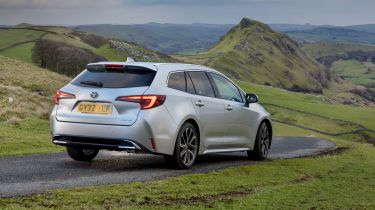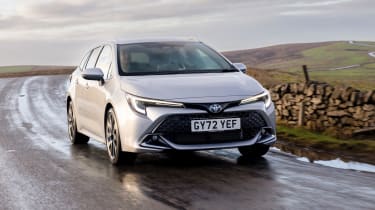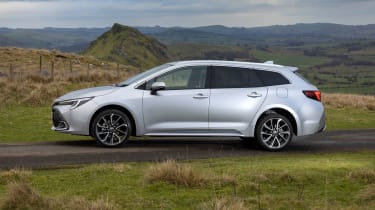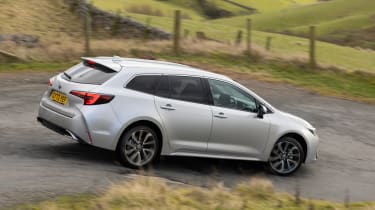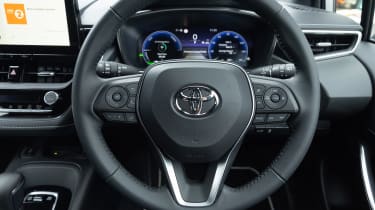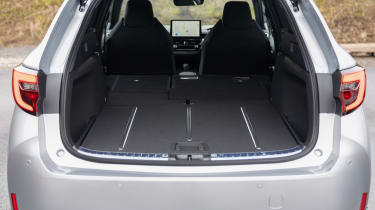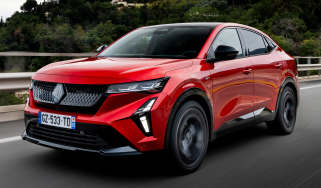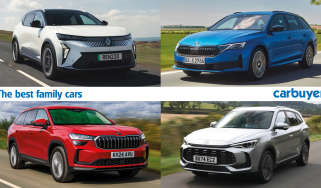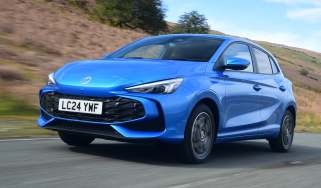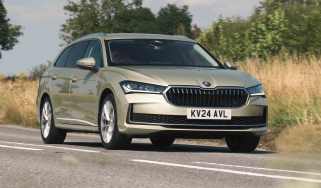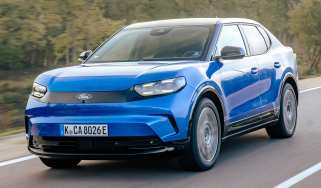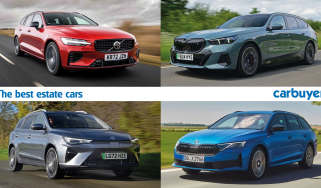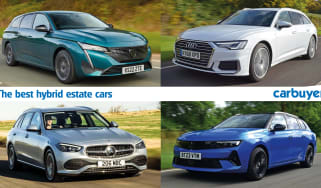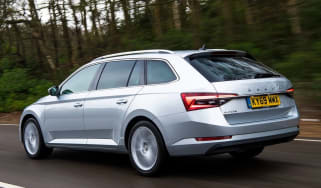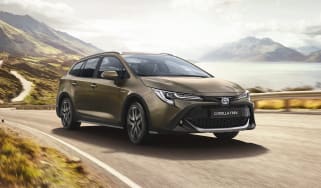Toyota Corolla Touring Sports estate review
"The Toyota Corolla Touring Sports is a family-friendly estate with economical, reliable hybrid powertrains"
Pros
- Smooth
- Practical
- Cheap to run
Cons
- Dull to drive
- No tax-busting PHEV
- Limited towing ability
Verdict - Is the Toyota Corolla Touring Sports a good car?
With its practical boot and a choice of two hybrid powertrains, the Corolla Touring Sports is a pretty unique proposition. If you don’t have a charger for a plug-in hybrid (PHEV) it’s a great option, and even if you do, the Toyota may still be worth considering. It undercuts most PHEVs on price, and if you travel further afield or have a high annual mileage it may work out just as fuel-efficient. Extra power for the updated 2023 car improves the driving experience, and its infotainment has also taken a step up in usability.
Toyota Corolla Touring Sports models, specs and alternatives
Although large estate cars have fallen in popularity in favour of SUVs, smaller estate cars based on family hatchbacks have remained fairly popular. The Toyota Corolla Touring Sports is one such example, adding an extra dose of practicality to the Corolla hatchback’s dependable formula.
SUVs and small crossovers aren’t for everyone, and the benefit to opting for a small estate like the Corolla instead is that it offers a familiar, low-down driving position which is comparatively more fun to drive, while still offering just as much boot space. This class is competitive, with rivals including the Ford Focus Estate, Volkswagen Golf Estate, Skoda Octavia Estate, and the Hyundai i30 Tourer.
In 2023, the Toyota Corolla Touring Sports got a mild facelift which brought some subtle styling changes and improved power for its hybrid engines, as well as an improved infotainment setup.
More reviews
The driving experience has improved relative to the Corolla’s predecessor, the Toyota Auris, thanks to a new chassis and, while it's still comfortable, the Touring Sports offers keen drivers a little more responsiveness too. The entire Corolla range is hybrid only, with either a 1.8-litre or 2.0-litre engine alongside an electric motor. A 1.2-litre turbo petrol was offered at launch but was withdrawn from sale due to low demand. The 1.8-litre hybrid setup will be familiar to Toyota Prius owners; it has bulletproof reliability and is capable of up to 62.7mpg in the Corolla. The 2.0-litre offers noticeably more punch but it's around £1,600 more expensive. That said, claimed efficiency is even better at up to 64.1mpg.
With its hybrid powertrain, the Corolla Touring Sports has few direct competitors. An increasing number of estate cars feature a plug-in hybrid powertrain, such as the SEAT Leon Estate, and BMW 330e Touring, but these tend to be more expensive than the Toyota. It’s a spacious, low-emission car that doesn’t need to be plugged in, which adds to its appeal for buyers who can’t or don’t want to recharge from a socket.
The Corolla estate has found favour with company car drivers, private buyers and even highway maintenance teams, so much so that there’s now a commercial version with the rear seats removed and a rugged loading area.
Due to the hybrid technology on board, the Touring Sports can't quite match the Ford Focus Estate for outright space but with room for four adults to get comfy and a boot measuring up to 596 litres, it's not too far behind. Safety is backed up by a five-star Euro NCAP score and the Corolla came 41st out of the top 75 models in our 2023 Driver Power survey, so ownership should be a breeze. Overall the Corolla has very few downsides, and while it may fail to tug at the heartstrings, factors like cheap running costs and a warranty lasting up to 10 years (as long as you continue to get it serviced every year via a main dealer) could be a deciding factor for some buyers.
MPG, running costs & CO2
Just like the Toyota Corolla hatchback, the Touring Sports estate is only offered with a choice of two hybrid powertrains. The more affordable 1.8-litre hybrid (shared with the Toyota Prius) is likely to be the most popular, and it's also impressively cheap to run. It manages official figures of up to 62.7mpg depending on trim level, while CO2 emissions are 101-111g/km – virtually matching the Toyota Corolla hatchback. This results in a reasonable Benefit-in-Kind (BiK) rating for company-car buyers; a plug-in hybrid (PHEV) or electric vehicle (EV) would be even lower, but an equivalent diesel Volkswagen Golf Estate would cost far more. Toyota claims the hybrid powertrain can spend up to 80% of its time with the petrol engine off in urban driving, and our drive suggested this could be feasible in stop-and-start conditions.
Upgrade to the more powerful 2.0-litre hybrid and fuel consumption actually improves slightly, to a maximum of 64.1mpg, with CO2 emissions from 100-108g/km depending on trim. It's a fairly small difference, and any savings at the pumps are likely to be balanced out by slightly higher insurance costs. The entry-level Icon model sits in group 17 (out of 50 bands), while the 2.0-litre GR Sport version sits in group 21. Every version of the Corolla Touring Sports will cost the discounted rate each year in (VED) road tax.
In 2021, Toyota made its warranty cover even more generous. Every new Toyota can now come with up to 10 years or 100,000 miles of cover, which is unmatched in the car industry. One of the only stipulations is that you need to have your car serviced at a main dealer. If you purchase used, you can still take advantage of the 10-year warranty as long as you keep up the main dealer servicing.
Engines, drive & performance
The latest Toyota Corolla handles competently but its CVT automatic gearbox and fairly soft settings means it still isn't especially fun to drive. Still, the chassis is surprisingly composed for a Toyota estate, taking tricky roads in its stride and keeping most vibrations out of the interior. Despite its 20mm increase in ride height, the Corolla Trek feels just as good to drive, but with the same front-wheel drive layout as the regular car, it offers little real advantage off-road aside from extra ground clearance to negotiate rocks and ruts. The combination of a petrol engine and electric motor still makes the most sense around town, where the car feels smooth and relaxing, with bursts of electric driving. Sitting silently in traffic with the engine off only reminds you of the fuel you're saving, too.
A GR Sport version is also offered, which is similar in style to the Ford Focus Estate in ST-Line. There are sportier alloy wheels and a body kit, but this is something of a sheep in wolf's clothing, as there are no mechanical changes to spice up the driving experience.
Toyota has two decades of experience in making hybrids, and the switch between electric and petrol propulsion is almost seamless on the move. We haven’t sampled the facelifted 2.0-litre with 193bhp yet, but even before it was updated (with slightly less power) the range-topping version was smooth to accelerate up to speed. Now it can get from 0-62mph in 7.7 seconds, so should be fast enough for its target buyers. There are steering wheel mounted gearshift paddles that go through 'virtual' gears programmed into the CVT automatic but we preferred leaving it to its own devices. It's one of the best CVT gearboxes available, keeping revs low most of the time so the engine rarely feels strained.
For 2023, the 1.8-litre model’s power was increased to 138bhp, cutting its 0-62mph acceleration figure from 11.1 seconds to 9.4 – a noticeable improvement. We found it was relatively easy to coax the electric motor to take over, and even on a mixed driving route the car we tested had its engine off for more than half the time. Throttle response is better than before, and there’s less droning from the CVT automatic gearbox, which also feels more direct in the way it transfers power from the engine to the road.
Interior & comfort
The hybrid powertrain helps the Corolla Touring Sports feel very refined during urban driving, and its soft suspension is better than that of the Ford Focus Estate in smothering bumps. If you want a comfortable and stress-free family estate, the Toyota is hard to beat.
Interior quality takes a noticeable step forward for Toyota too, with lots of padded materials and less scratchy, brittle plastics on show. It still isn't quite on the level of a Skoda Octavia Estate or a Golf Estate but this is far from a deal-breaker. When the Corolla first launched, its central infotainment system was a long way off the best in class, but it's now been updated so you can at last use Android Auto or Apple CarPlay, along with familiar apps like Google Maps and Spotify. The screen itself is more responsive and has crisper graphics, while the menus for the facelifted Corolla have also been simplified to make them more intuitive to navigate.
Trim levels consist of Icon, Design, GR Sport and Excel with 16-inch alloy wheels, dual-zone climate control, LED headlights and a 10.5-inch display with a rear-view camera as standard. The facelifted model also gets a 12.3-inch digital instrument cluster. Icon Tech added sat nav, front and rear parking sensors and voice recognition, but it’s no longer offered.
Instead you’ll need to step up to Design, which boosts the car’s appearance with a set of 17-inch wheels. Convenience is also improved with folding door mirrors, auto wipers, privacy glass and LED ‘Dual-beam’ headlights. Excel adds luxuries like ambient lighting, a head-up display, 18-inch wheels, part-leather and Alcantara seats, and upgraded ‘Multi-beam’ headlights.
GR Sport looks the most dynamic as it’s inspired by Toyota's racing division. It has model-specific 18-inch alloy wheels, styling changes such as a dark mesh grille, sports seats and red stitching for the steering wheel and gearlever.
Designed in partnership with the bike brand of the same name, the Trek model was altogether more outdoorsy, with a 20mm increase in ride height, SUV-style bumpers and body cladding, keyless entry and a powered tailgate with hands-free opening. However, this version is no longer available.
Options include a contrasting paint finish for the roof, a panoramic sunroof and a Protection Pack with mudflaps, boot-liner, cargo nets and rubber floormats.
Practicality & boot space
There's plenty of room in the front seats of the Corolla Touring Sports, although the fairly flat seats speak volumes about the sort of driving Toyota expects owners will be doing. Room in the back is average, so there's enough room for most occupants but taller passengers may find headroom is restricted.
It's a similar story for the boot, which at up to 596 litres (for the 1.8-litre model) should be more than big enough for most families, without setting any class records. Choose the 2.0-litre version and it shrinks slightly to 581 litres, while maximum cargo space with the seats folded is 1,606 and 1,591 litres for the 1.8 and 2.0 respectively. This compares to the 608/1,650 litres offered by the Ford Focus Estate, which doesn’t have to fit an electric battery under the boot.
The rear seats split and fold 60:40, with handy levers just inside the boot to operate them. If you live in the countryside or own a dog, the Full Protection Pack is worth considering, adding mud flaps, a boot-liner and rubber floor mats.
One thing to note is that caravanners won't be well served by Corolla Touring Sports Hybrid, because of the car’s limited 750kg limit for braked trailers, which decreases even further to 450kg for unbraked trailers. The now discontinued 1.2-litre petrol is better thanks to a 1,300kg towing capacity.
Reliability & safety
Toyota is well-known for making reliable cars, and its hybrid models are garnering a reputation for being particularly robust and affordable to own. The Corolla is also a safe model to buy according to independent crash tests.
While the Corolla is a fairly recent model, it's a safe bet to say the Derbyshire-built Corolla should prove a hassle-free investment. It came an impressive seventh out of the top 75 new cars in our 2020 Driver Power survey, dropping slightly to 38th in 2022 and to 41st in 2023, but still with a good score for reliability and build quality. Owners praised its engine and gearbox, along with its ride and handling. Running costs also impressed, but infotainment didn't receive such a high score.
The Toyota Corolla hatchback was awarded a five-star rating by Euro NCAP, with a 95% score for adult occupant protection. This score should also translate to the Touring Sports, with identical standard safety kit designed to help prevent a collision, along with passive protection should it be unavoidable.
Standard safety equipment includes a reversing camera, lane-departure alerts, road sign assist and an adjustable speed limiter. Every trim level also gets adaptive cruise control as standard, but you’ll need to upgrade to Excel trim for rear cross-traffic alerts, which can also brake the car if passing traffic is detected. Autonomous emergency braking (AEB) is standard, and can now detect pedestrians during the day or night, and cyclists during daylight hours.
Which Is Best?
Cheapest
- Name1.8 Hybrid Icon 5dr CVT
- Gearbox typeAuto
- RRP£31,840
Most Economical
- Name1.8 Hybrid Design 5dr CVT
- Gearbox typeAuto
- RRP£33,475
Fastest
- Name2.0 Hybrid Icon 5dr CVT
- Gearbox typeAuto
- RRP£33,585

